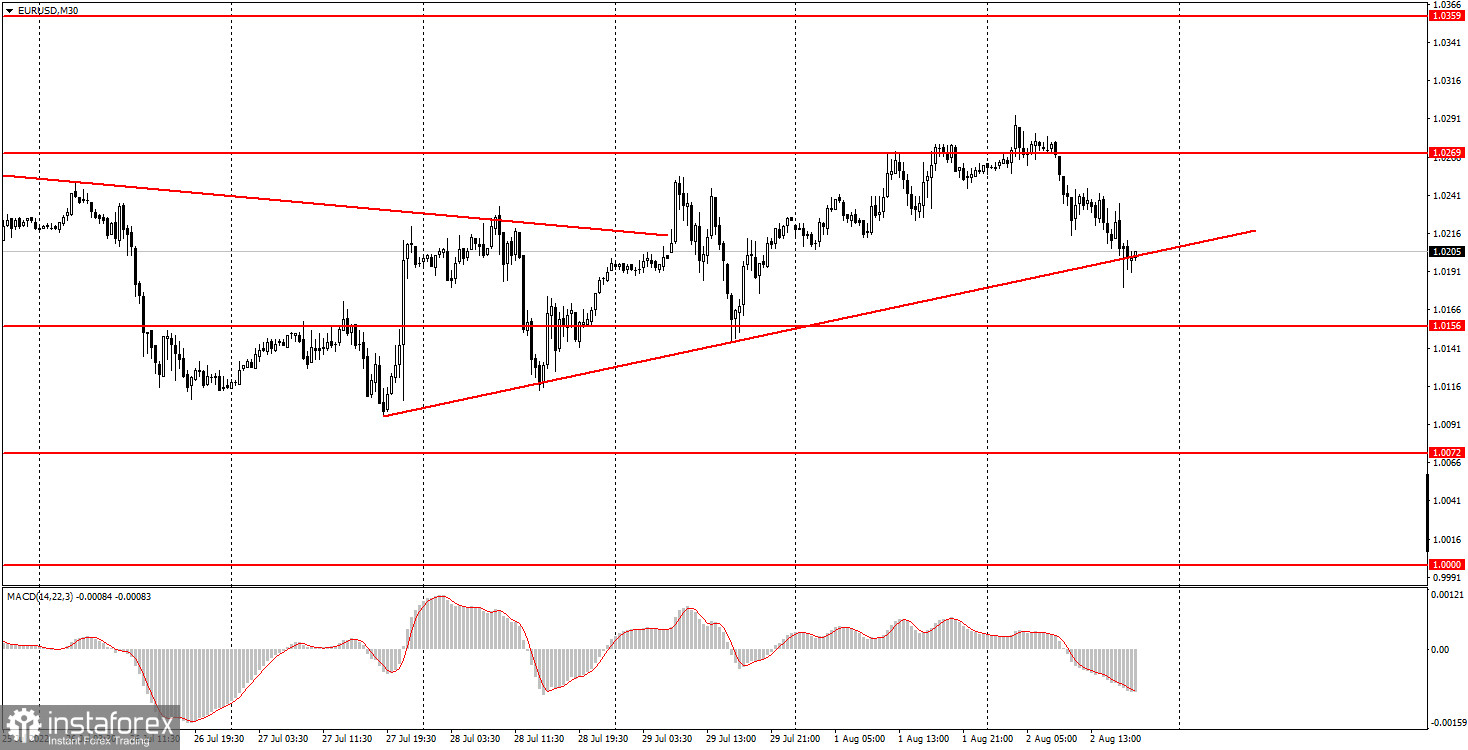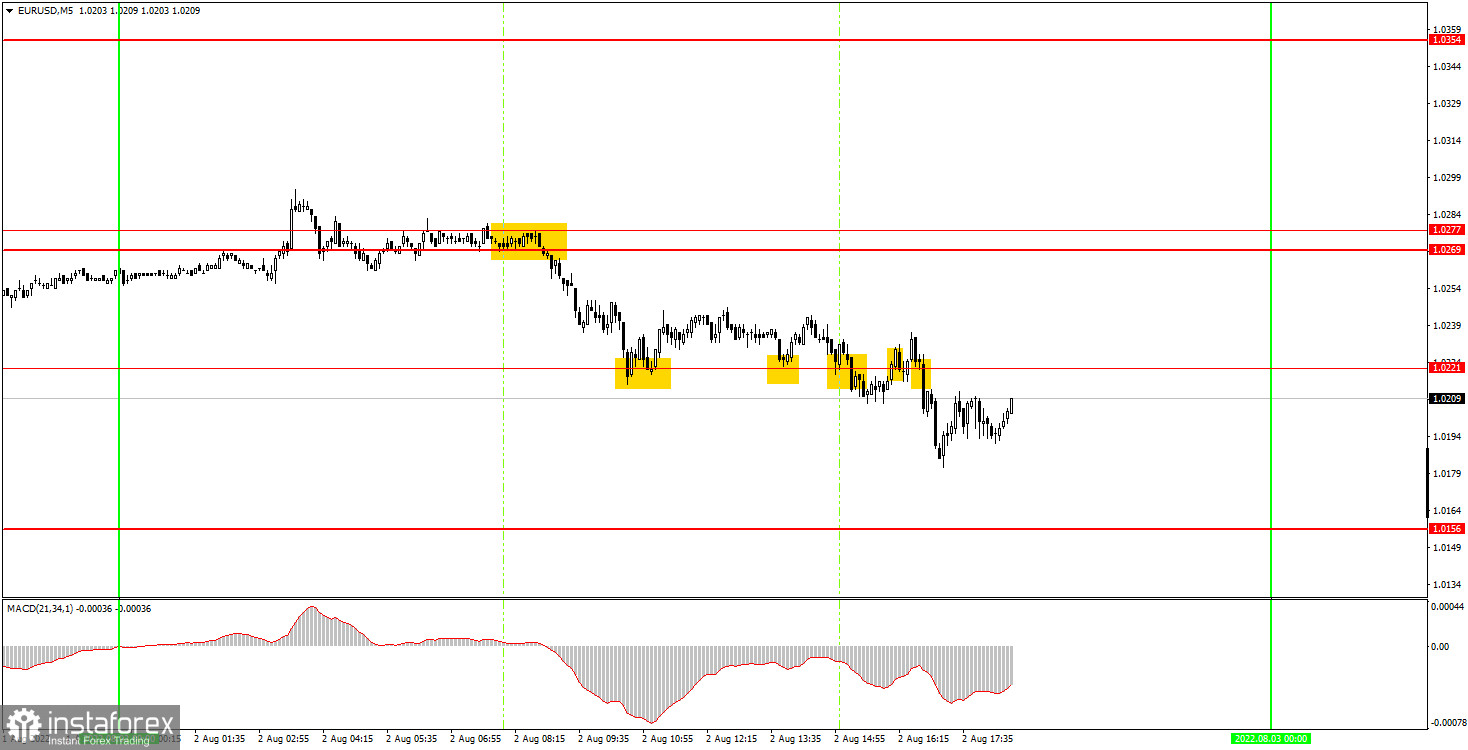Analysis of Tuesday's deals:
30M chart of the EUR/USD pair

The EUR/USD currency pair fell quite sharply to the rising trend line and tried to settle below it for two hours. It failed to do so, and the short-term upward trend continues, and the euro retains chances for a weak growth. We remind you that the euro has been growing in recent weeks with great difficulty, which can be clearly seen on any higher timeframe. This indicates, first of all, that the bears have taken a break, and the bulls are not eager to buy the euro. The conclusion is obvious: the euro will resume to fall and, probably, with a new update of 20-year lows. However, before the price settles below the trend line, you should not rush to sell the pair. There were few important macroeconomic data on Tuesday. Or rather, it didn't exist at all. The market discussed the Sino-Taiwan conflict all day, which was provoked by the visit of US Congress Speaker Nancy Pelosi to the capital of the partially recognized Republic of Taiwan. However, as it became known in the last few hours, Pelosi's plane landed safely in Taipei and the speaker will meet with the President of Taiwan on Wednesday, after which she will depart back. Therefore, for the time being, it cannot be said that a new conflict has flared up between the US and China.
5M chart of the EUR/USD pair

Tuesday's movements on the 5-minute timeframe were not the best. If there were signs of a downward trend at the beginning of the European trading session, then the movement died. The strongest signal of the day was formed at the beginning of the European session. The price settled below the area of 1.0269-1.0277, after which it dropped to the level of 1.0221. It was possible to earn about 30 points on a short position. This was followed by a series of false signals. The pair began to "dance" around the level of 1.0221, forming a total of five signals. All are false. Beginners could try to work out the first two buy signals, since at that time the new nature of the movement was not yet clear. However, the pair failed to go up even 15 points after two attempts, so the deal closed at a loss when the price settled below the level of 1.0221. Short positions should have been opened on the same sell signal, which also did not bring profit to traders, as the pair immediately turned up and settled above 1.0221. Further, all subsequent signals near the level of 1.0221 should not have been worked out. It is unlikely that the day ended in profit, but it will not be in loss either, thanks to the first deal.
How to trade on Wednesday:
There is currently a slight upward trend on the 30-minute time frame, but the price needs to stay above the trend line in order to count on a new strengthening. We still doubt the euro's ability to continue its upward movement for a long time, but it should be recognized that the euro can still continue to rise in price at a low pace. On the 5-minute TF on Wednesday, it is recommended to trade at the levels of 1.0072, 1.0123, 1.0156, 1.0221, 1.0269-1.0277, 1.0354, 1.0383. When passing 15 points in the right direction, you should set Stop Loss to breakeven. The US and the European Union will publish indexes of business activity in the services sector. In case of a strong deviation of the actual value from the forecast, these data may cause a certain reaction of the market, but hardly a strong one. There will also be a report on retail sales in the EU, which is also unlikely to overly interest traders.
Basic rules of the trading system:
1) The signal strength is calculated by the time it took to form the signal (bounce or overcome the level). The less time it took, the stronger the signal.
2) If two or more deals were opened near a certain level based on false signals (which did not trigger Take Profit or the nearest target level), then all subsequent signals from this level should be ignored.
3) In a flat, any pair can form a lot of false signals or not form them at all. But in any case, at the first signs of a flat, it is better to stop trading.
4) Trade deals are opened in the time period between the beginning of the European session and until the middle of the US one, when all deals must be closed manually.
5) On the 30-minute TF, using signals from the MACD indicator, you can trade only if there is good volatility and a trend, which is confirmed by a trend line or a trend channel.
6) If two levels are located too close to each other (from 5 to 15 points), then they should be considered as an area of support or resistance.
On the chart:
Support and Resistance Levels are the Levels that serve as targets when buying or selling the pair. You can place Take Profit near these levels.
Red lines are the channels or trend lines that display the current trend and show in which direction it is better to trade now.
The MACD indicator (14,22,3) consists of a histogram and a signal line. When they cross, this is a signal to enter the market. It is recommended to use this indicator in combination with trend lines (channels and trend lines).
Important speeches and reports (always contained in the news calendar) can greatly influence the movement of a currency pair. Therefore, during their exit, it is recommended to trade as carefully as possible or exit the market in order to avoid a sharp price reversal against the previous movement.
Beginners on Forex should remember that not every single trade has to be profitable. The development of a clear strategy and money management are the key to success in trading over a long period of time.





















